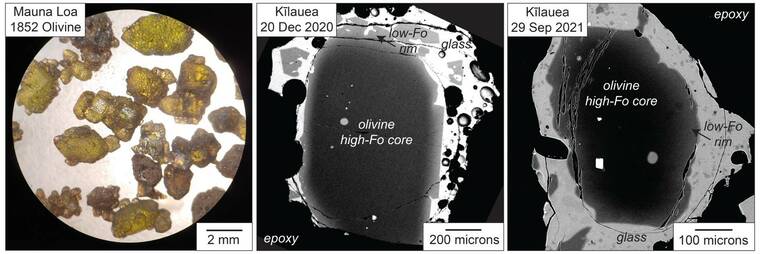Olivine crystals — the beautiful green mineral common in Hawaiian lavas — record when and where magmas move inside Hawaiian volcanoes before they erupt. We can actually use these little crystals like clocks to better understand the magmatic events leading to the December 2020 and September 2021 summit eruptions at Kilauea.
Lavas and their minerals erupted from Hawaiian volcanoes provide clues to the history of the magmas that are eventually erupted. Kilauea’s recent summit eruptions allow us “a glimpse inside” the volcano and the chance to learn more about where the magma erupted in Halema‘uma‘u crater came from and how quickly it moved to the surface.
Geologists measure the chemistry of the erupted materials — including rapidly cooled lava (glass), minerals, and dissolved gases or gas bubbles — to find out how hot the magma was, how long it sat inside the volcano prior to erupting at the surface, and how different magmas might have mixed (older and cooler versus fresher and hotter magma).
Olivine is primarily made of the elements magnesium (Mg) and iron (Fe) along with silica. The ratio of Mg and Fe, also known as the forsterite (Fo) content, can tell us several things about the magma that the crystal grew in.
Higher Mg in olivine (and therefore higher Fo) means that crystals grew in hotter, and usually deeper, magmas. If the olivine Fo content is low, it tells us that crystals grew in a cooler, and usually shallower, magma.
After searching for olivine crystals in tephra (pumice, ash, and Pele’s hair) erupted by Kilauea in December 2020 and September 2021, USGS Hawaiian Volcano Observatory (HVO) scientists worked with the electron microprobe lab housed at the University of Hawaii at Manoa to take pictures of the insides of the olivine crystals.
These images show that Kilauea’s recently erupted olivine can be zoned, meaning that the cores (or insides of the crystals) have different Fo than their rims (the exterior edges of the crystals). These examples show what we call normal zoning — where Fo decreases from the inside of the crystal to the outside.
Normal zoning in these crystals tells us that they first grew in a deeper, hotter part of Kilauea and then the rims of the crystals grew later after the magma had moved to a shallower, cooler region.
The presence of zoned crystals is rather exciting for Kilauea’s summit — olivine from the lava lake that was active from 2008–2018, prior to the 2018 summit collapse, were typically homogeneous, meaning that they didn’t have any zoning.
These changes in olivine Fo are also special because they actually record time through a process called diffusion. Think about putting your cold hands on a warm mug of tea or coffee. Thermal diffusion allows the heat from the mug to move into and warm your hands.
In the same general process, Mg atoms from the olivine core can diffuse toward its rim over time while the olivine sits in a hot magma. By measuring the change in Fo from core to rim, and then applying a model of this change, we can calculate how long crystals sat at the shallower level where the rims grew before they erupted.
Kilauea’s 2020 olivine crystals have modeled diffusion times of about 60 days or less. This suggests that the crystals, which originally grew deeper in the volcano, moved up to shallow regions (a few km or less than a couple miles below the ground surface) about 60 days before they erupted.
Around 60 days before Kilauea’s December 2020 eruption, in late October, HVO detected the first set of earthquake swarms during the period of unrest leading to the eruption. Though the initial earthquake swarm occurred under Namakanipaio Campground, the modeled olivine crystal diffusion times suggest that the earthquakes could have been a sign that magma was intruding shallowly under Kilauea’s summit.
In the next few weeks, olivine crystals from Kilauea’s eruption that began on September 29 will be measured on the USGS California Volcano Observatory’s electron microprobe.
The data will then be modeled to calculate the timescales from these most recent “crystal clocks,” letting us know if the same process was repeated this Fall or if something new and different happened prior to the most recent eruption of Kilauea.
Volcano
activity updates
Kilauea volcano is erupting. Its USGS Volcano Alert level is at WATCH (https://www.usgs.gov/natural-hazards/volcano-hazards/about-alert-levels). Kilauea updates are issued daily.
Lava continues to erupt from a single vent in the western wall of Halema‘uma‘u crater. All lava activity is confined within Halema‘uma‘u crater in Hawai‘i Volcanoes National Park. Sulfur dioxide emission rates remain elevated and were measured at approximately 250 tonnes per day on Nov. 8, 2021. Seismicity is elevated but stable, with few earthquakes and ongoing volcanic tremor.
Summit tiltmeter data has remained relatively flat over the past week, with brief inflationary and deflationary signals early this week. For more information on the current eruption of Kilauea, see Recent Eruption (usgs.gov).
Mauna Loa is not erupting and remains at Volcano Alert Level ADVISORY.
This alert level does not mean that an eruption is imminent or that progression to an eruption from the current level of unrest is certain. Mauna Loa updates are issued weekly.
This past week, about 69 small-magnitude earthquakes were recorded below the summit and upper elevation flanks of Mauna Loa — the majority of these occurred at shallow depths less than 10 kilometers (6 miles). Global Positioning System (GPS) measurements show no major deformation over the past week. Gas concentrations and fumarole temperatures at both the summit and at Sulphur Cone on the Southwest Rift Zone remain stable. Webcams show no changes to the landscape. For more information on current monitoring of Mauna Loa, see: https://www.usgs.gov/volcanoes/mauna-loa/monitoring.
There was 1 event with 3 or more felt reports in the Hawaiian Islands during the past week: a M3.2 earthquake 3 km (1 mi) S of Pahala at 31 km (19 mi) depth on Nov. 8 at 2:25 p.m. HST.
HVO continues to closely monitor Kilauea’s ongoing eruption and Mauna Loa for any signs of increased activity.
Please visit HVO’s website for past Volcano Watch articles, Kilauea and Mauna Loa updates, volcano photos, maps, recent earthquake info, and more. Email questions to askHVO@usgs.gov.
Volcano Watch is a weekly article and activity update written by U.S. Geological Survey Hawaiian Volcano Observatory scientists and affiliates.






